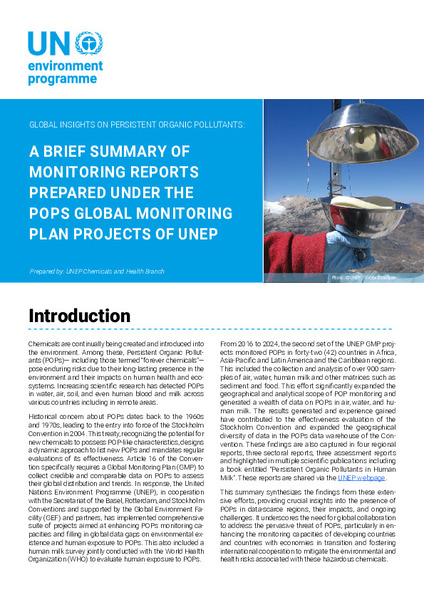| dc.contributor | Industry and Economy Division | en_US |
| dc.contributor.author | United Nations Environment Programme | en_US |
| dc.date.accessioned | 2024-06-12T11:19:35Z | |
| dc.date.available | 2024-06-12T11:19:35Z | |
| dc.date.issued | 2024-06 | |
| dc.identifier.uri | https://wedocs.unep.org/20.500.11822/45681 | |
| dc.description | This summary synthesizes the findings from these extensive efforts, providing crucial insights into the presence of POPs in data-scarce regions, their impacts, and ongoing challenges. It underscores the need for global collaboration to address the pervasive threat of POPs, particularly in enhancing the monitoring capacities of developing countries and countries with economies in transition and fostering international cooperation to mitigate the environmental and health risks associated with these hazardous chemicals. | en_US |
| dc.description.uri | https://www.unep.org/topics/chemicals-and-pollution-action/pollution-and-health/persistent-organic-pollutants-pops-4 | en_US |
| dc.format | pdf | en_US |
| dc.language | English | en_US |
| dc.rights | Public | en_US |
| dc.subject | persistent organic pollutant | en_US |
| dc.subject | chemistry | en_US |
| dc.subject | health | en_US |
| dc.subject | pollution | en_US |
| dc.title | A brief summary of monitoring reports prepared under the POPs Global Monitoring Plan Projects of UNEP | en_US |
| dc.type | Factsheets, Infographics and Brochures | en_US |
| wd.identifier.sdg | SDG 3 - Good Health and Well-Being | en_US |
| wd.identifier.sdg | SDG 10 - Reduced Inequalities | en_US |
| wd.identifier.sdg | SDG 11 - Sustainable Cities and Communities | en_US |
| wd.identifier.sdg | SDG 12 - Responsible Consumption and Production | en_US |
| wd.identifier.sdg | SDG 17 - Partnerships for the Goals | en_US |
| wd.topics | Chemicals and Pollution Action | en_US |
| wd.identifier.pagesnumber | 9 p. | en_US |


